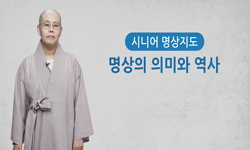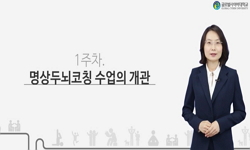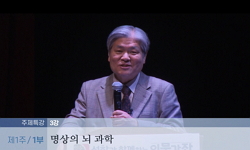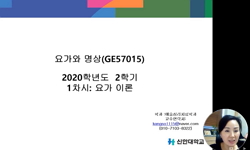This research, as a way of reflecting oneself, attempted to find out about the complementary relation between the Oriental Aptitude Counseling Theory and meditation. The most important factors in the Oriental Aptitude Counseling Theory are harmony and...
http://chineseinput.net/에서 pinyin(병음)방식으로 중국어를 변환할 수 있습니다.
변환된 중국어를 복사하여 사용하시면 됩니다.
- 中文 을 입력하시려면 zhongwen을 입력하시고 space를누르시면됩니다.
- 北京 을 입력하시려면 beijing을 입력하시고 space를 누르시면 됩니다.
자기보기의 방법으로서 동양적성이론과 명상 = To see who I am by Oriental Aptitude Counseling Theory and Meditation
한글로보기https://www.riss.kr/link?id=T12293146
- 저자
-
발행사항
양산 : 영산대학교 동양학대학원, 2011
-
학위논문사항
학위논문(석사) -- 영산대학교 동양학대학원 , 동양적성상담 , 2011. 2
-
발행연도
2011
-
작성언어
한국어
-
주제어
동양적성(사주명리학) ; 명상 ; 자기보기 ; 자기치유
-
발행국(도시)
경상남도
-
형태사항
87 p. ; 26cm
- 소장기관
-
0
상세조회 -
0
다운로드
부가정보
다국어 초록 (Multilingual Abstract)
This research, as a way of reflecting oneself, attempted to find out about the complementary relation between the Oriental Aptitude Counseling Theory and meditation. The most important factors in the Oriental Aptitude Counseling Theory are harmony and balance. The harmony and balance can only be achieved when one is well meditatively trained, penetrating the essence and discarding the sense of obsession, arrogance or selfishness. Through the Oriental Aptitude Counseling Theory, the meditation attempted to suggest an idea that when we meditate with knowing about 'true self,' 'the place pain comes from, and a way of remedying those pain,' the effect of meditation doubles. Not only that, accommodating the meditation to solve the problem with "not knowing what and how to solve problems" will help as a guide.
In order to develop such argument, Firstly, this research pointed out the meaning of meditation as "through congregating one's consciousness into one object and closely examining various events happening throughout life, one will maximize the sense of peace and lose the feeling of pain to find the true self(self remedy)." Especially, it investigated about 'examination' and 'self-remedy' as common factors in both meditation and Oriental Aptitude Counseling Theory.
Secondly, it examined about the effects of meditation by investigating the experiment results applied in psychotheraphy, brain science and real clinic performances to find the therapeutic matter of meditation with examination of "relaxation of feeling through codification, accepting true self, improvements in self-control ability and changes in attitude, an expansion of self-examination skill bringing improvements in self-control skills and the interaction of effect of affectivity on the immune system and nervous system.' Such treatment is demonstrated through the Oriental Aptitude Counseling Theory, knowing and accepting true self.
Thirdly, it investigated about the paradoxical effects of meditation and their causes of individual's characteristics, self-examination attitude and 'not knowing what and how to do.' The Oriental Aptitude Counseling Theory is thus suggested as a way of solving this problem. It is the study that does not approach fate from a fortune-telling position but applies self-examination factors including reflection of one's tendency, reflection of past days and finding of life patterns to make these factors objectified and educated.
Forthly, it investigated about the core factors of the Oriental Aptitude Counseling Theory, self-examination and pain and remedy. By examining oneself through understanding the characteristics and the relation of tendency among 10 different kinds of tendencies, one can perceive and understand others'(including self) characteristics. By examining the aspects and the reasons for pain through self-examination and providing an explanation for control, this research attempted to solve the problem with the limit of meditation "not knowing what, how to do."
Fifthly, by providing case examples of people who studied the Oriental Aptitude Counseling Theory, this research attempted to provide more reliable sources.
To solve the problem with the limit of meditation, it attempted to suggest the Oriental Aptitude Counseling Theory with the case examples of people who studied the Oriental Aptitude Counseling Theory. But these cases can be limited with subjective results. However, meditation and remedy are originally subjective that they can only be experienced by individual. Thus, such limit needs more objective clinical experiments which is expected to be solved by future experiments.
국문 초록 (Abstract)
본 연구는 자기보기의 방법으로서 동양적성이론과 명상의 상보적인 관계를 모색하고자 하였다. 동양적성이론에서 가장 중요한 원칙은 조화와 균형이다. 조화와 균형점은 집착이나 오만, 자...
본 연구는 자기보기의 방법으로서 동양적성이론과 명상의 상보적인 관계를 모색하고자 하였다. 동양적성이론에서 가장 중요한 원칙은 조화와 균형이다. 조화와 균형점은 집착이나 오만, 자신의 이기심이나 사심을 버리고 본질을 꿰뚫을 수 있는 명상수련이 되어야 잘 찾을 수 있다. 명상은 동양적성이론을 통하여 ‘있는 그대로의 나’, ‘나의 고통이 어디에 기인하는지, 어떻게 그 고통을 치유할 수 있는지’를 알고 수행하면 명상의 효과를 배가시킬 수 있을 뿐더러 명상의 수용이라는 부분에서의 “무엇을, 어떻게 해야 할지 모름”을 해결하여 명상의 길잡이 역할을 할 수 있다는 것을 제시하고자 하였다.
이러한 논점을 전개하기 위하여
첫째, 명상의 의미와 종류를 알아보며 명상을 “일차적으로 의식을 어느 하나의 대상에 모으는 훈련을 통하여 삶의 전반에 걸쳐 일어나는 각가지 일들을 고요히 살펴봄으로서 궁극적으로 내적 평온감이 극대화되어 고통거리가 사라지고 진정한 자기(자기치유, 참 나 중득)를 만날 수 있도록 하는 것”으로 정리하여 특히 ‘살펴봄(바라봄)’, ‘자기치유’를 명상과 동양적성이론의 공통분모로 탐색하였다.
둘째, 명상의 효과에 대하여 심리치료, 뇌과학, 실제 임상에 도입한 연구성과 중심으로 탐색하였다. 명상의 치료적 기제를 ‘언어화함으로서 감정의 완화, 있는 그대로의 자신을 수용함, 자기조정능력의 향상과 태도의 변화, 자기탐지력의 증가가 자기조절능력의 증가를 가져옴, 감정상태가 면역계에 영향을 미치는 면역계와 신경계의 상호작용’으로 살펴보았다. 이러한 치료기제는 동양적성이론을 통해 자기 자신을 알고 받아들이는 과정을 통해서도 나타날 수 있다.
셋째, 명상의 역설적 효과를 탐색하여 그 원인으로 개인의 성격적 특성과 자기 자신을 바라보는 태도, ‘무엇을, 어떻게 해야 할 지 모름’으로 살펴보았다. 이를 해결할 수 있는 방안으로 동양적성이론을 제시하였다. 사주를 점(占)의 입장에서 접근하지 않고, 기존의 이론을 바탕으로 하여 자기 성향 돌아보기, 스스로 살아온 날 돌아보기, 그리고 삶의 패턴과 주기 찾아보기 등의 자기를 성찰하고 관조하는 자기 상담 도구로 응용하여 검증하고 객관화, 학문화한 것이 동양적성이론이다.
넷째, 동양적성이론의 가장 중요한 핵심인 성향으로 자기보기와 고통과 치유에 대하여 살펴보았다. 열 가지 성향의 모습, 자리별 성향의 특징과 성향의 관계를 통해 성향으로 자기보기를 함으로서 나를 포함한 다양한 사람들의 성격특성을 바라보고 인정하고자 하였다. 이러한 자기보기를 바탕으로 고통을 성향의 지나침과 없음, 성향자체의 고통, 신약․신강에서의 고통으로 나누어 그 모습과 원인을 살펴보았다. 고통을 어떻게 조절해야 하는지를 에너지의 강약과 성향의 관계를 원칙으로 설명하여 명상의 한계의 한 요인인 “무엇을, 어떻게 해야 할 지 모름”을 해결하고자 하였다.
다섯째, 자기보기 명상의 실례들로 동양적성이론을 공부한 사람들의 사례를 들어 위의 논점의 실증적 근거를 제시하였다.
명상의 한계를 극복하는 방안으로 동양적성이론을 제시하며 수년간 동양적성이론을 공부한 사람들의 실례를 살폈으나 그 실례들이 다소 주관적일 수 있는 한계가 있다. 그러나 명상이나 치유라는 것이 원래 주관적이며 개인적인 경험일 수 밖에 없다는 데에서 그 한계는 좀 더 객관적인 임상 실험이 필요함으로 추후의 연구과제로 남긴다.
목차 (Table of Contents)
- Ⅰ. 서론 1
- 1. 연구목적과 문제제기 1
- 2. 연구내용 및 연구의 제한점 6
- Ⅱ. 명상에 대한 이해 8
- 1. 명상의 종류와 의미 8
- Ⅰ. 서론 1
- 1. 연구목적과 문제제기 1
- 2. 연구내용 및 연구의 제한점 6
- Ⅱ. 명상에 대한 이해 8
- 1. 명상의 종류와 의미 8
- 가. 명상의 종류와 의미 8
- 나. 바라보기로서의 마음챙김(알아차림) 명상 12
- 2. 명상의 효과 14
- 가. 명상의 효과 14
- 나. 명상의 치유적 기제 21
- 3. 명상의 한계 및 극복방안 25
- 가. 명상의 역설적 효과 및 그 원인 25
- 나. 명상의 한계를 극복하기 위한 방안으로서의 동양적성이론 31
- Ⅲ. 동양적성이론과 명상 35
- 1. 성향으로 자기보기 35
- 가. 나는 어떤 성향의 사람인가? 35
- 나. 자리별 성향의 특징과 성향의 관계 44
- 2. 고통과 치유 49
- 가. 나의 고통 바라보기 49
- 나. 고통 조절하기 56
- Ⅳ. 자기 보기 명상의 실례들 62
- Ⅴ. 결론 및 연구의 제한점 76
- 참고문헌 79
- Abstract 82












